Macroeconomics Assignment: Analyzing Trade, Tariffs, and Global Impact
VerifiedAdded on 2023/06/16
|10
|2257
|59
Homework Assignment
AI Summary
This macroeconomics assignment covers various aspects of international trade and balance of payments. It discusses arguments for and against free trade, the role of the World Trade Organization (WTO), and ways to implement protectionism. The assignment analyzes the impact of the trade war between the US and China, including its long-term effects on both economies. It also explains the concept of balance of payments, differentiating between current and capital accounts. Furthermore, the assignment includes problem-solving related to absolute and comparative advantage, trade balance calculations, and current account balance assessments. The case study examines the author's disagreement with Trump's tariff policies, the suitability of free trade for countries like China and North Korea, and the geographical disadvantages faced by Pakistan. Finally, it touches upon the potential interference of the US government in the consumption choices of its citizens regarding international tourism. Desklib offers numerous similar solved assignments and study tools for students.
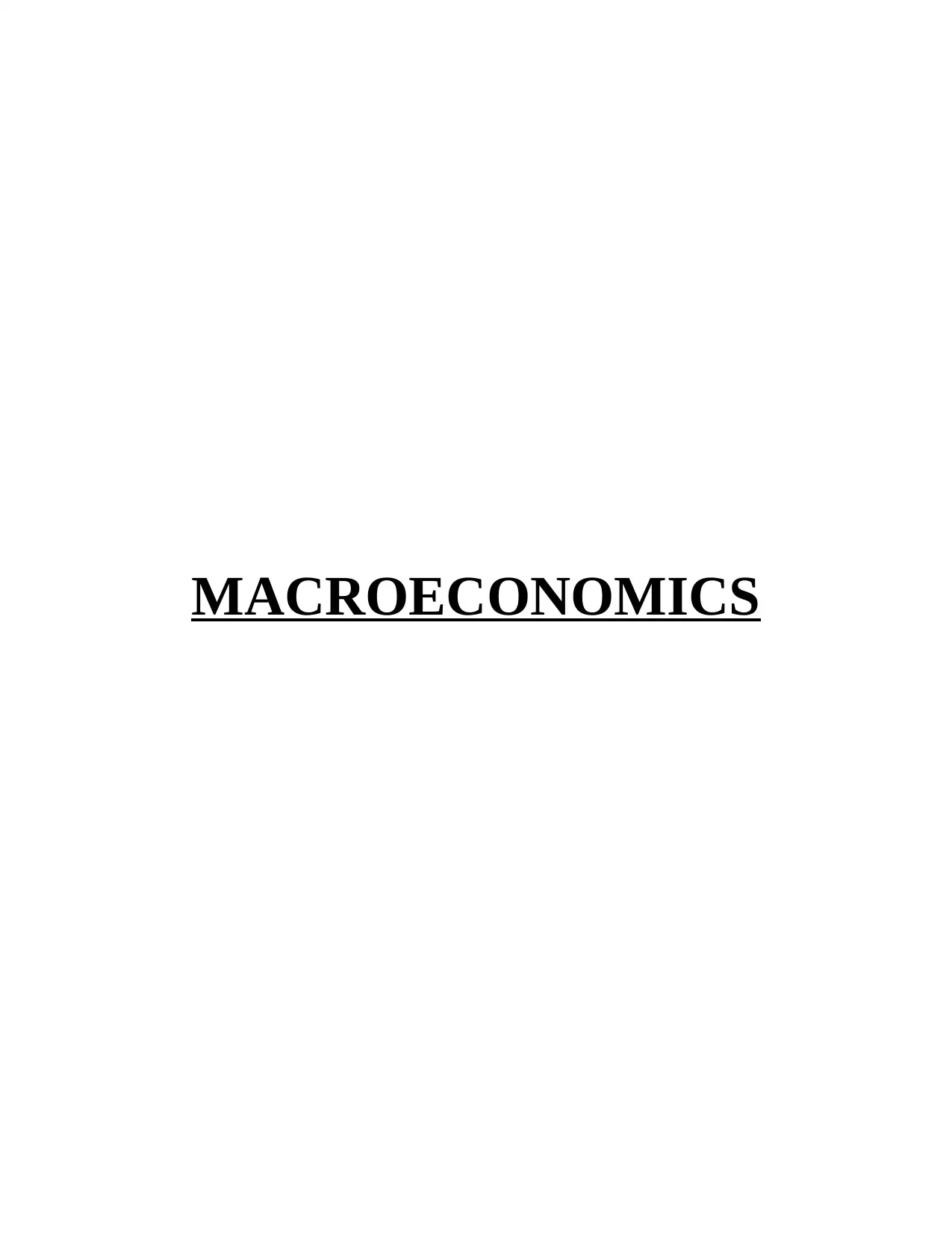
MACROECONOMICS
Paraphrase This Document
Need a fresh take? Get an instant paraphrase of this document with our AI Paraphraser
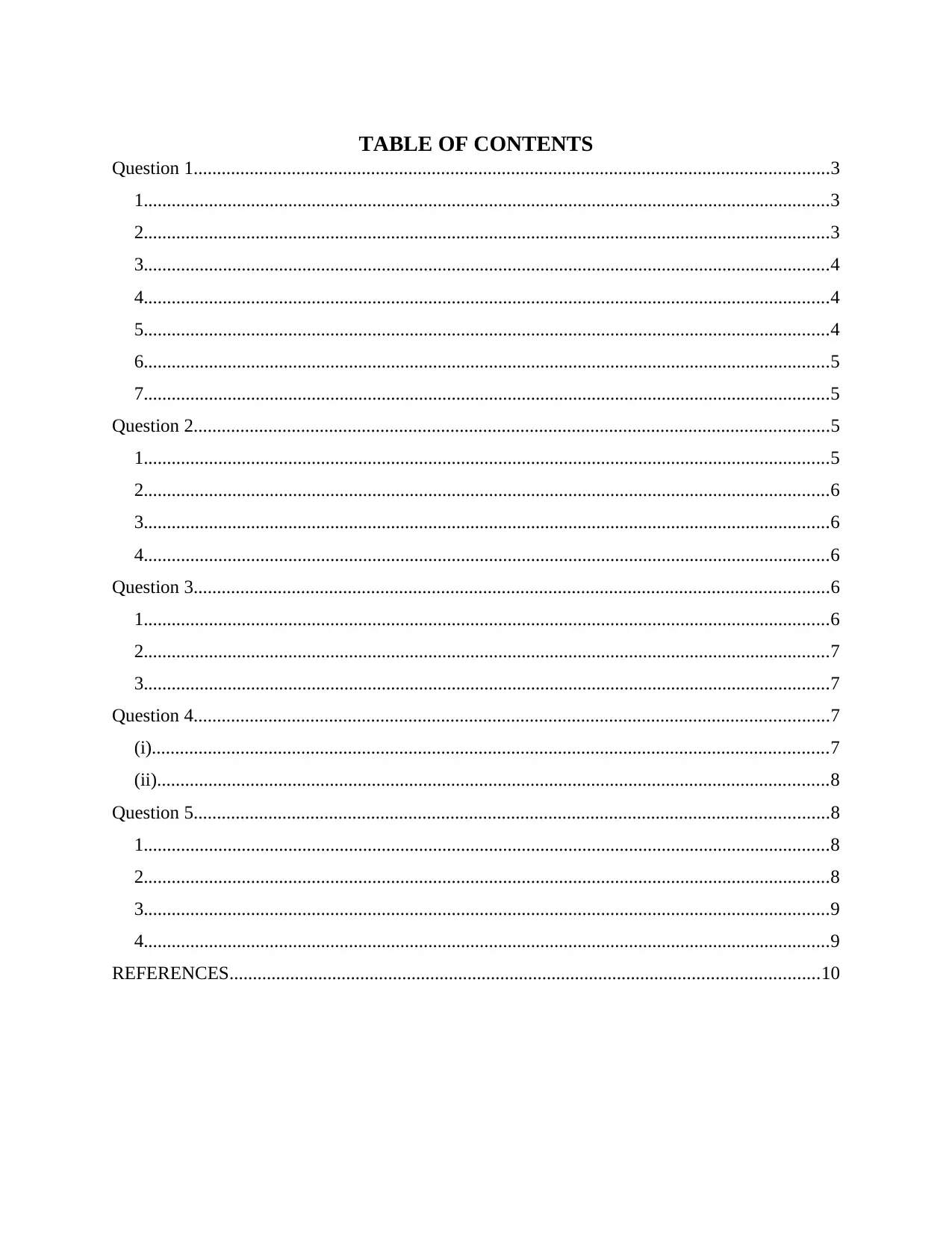
TABLE OF CONTENTS
Question 1........................................................................................................................................3
1...................................................................................................................................................3
2...................................................................................................................................................3
3...................................................................................................................................................4
4...................................................................................................................................................4
5...................................................................................................................................................4
6...................................................................................................................................................5
7...................................................................................................................................................5
Question 2........................................................................................................................................5
1...................................................................................................................................................5
2...................................................................................................................................................6
3...................................................................................................................................................6
4...................................................................................................................................................6
Question 3........................................................................................................................................6
1...................................................................................................................................................6
2...................................................................................................................................................7
3...................................................................................................................................................7
Question 4........................................................................................................................................7
(i).................................................................................................................................................7
(ii)................................................................................................................................................8
Question 5........................................................................................................................................8
1...................................................................................................................................................8
2...................................................................................................................................................8
3...................................................................................................................................................9
4...................................................................................................................................................9
REFERENCES..............................................................................................................................10
Question 1........................................................................................................................................3
1...................................................................................................................................................3
2...................................................................................................................................................3
3...................................................................................................................................................4
4...................................................................................................................................................4
5...................................................................................................................................................4
6...................................................................................................................................................5
7...................................................................................................................................................5
Question 2........................................................................................................................................5
1...................................................................................................................................................5
2...................................................................................................................................................6
3...................................................................................................................................................6
4...................................................................................................................................................6
Question 3........................................................................................................................................6
1...................................................................................................................................................6
2...................................................................................................................................................7
3...................................................................................................................................................7
Question 4........................................................................................................................................7
(i).................................................................................................................................................7
(ii)................................................................................................................................................8
Question 5........................................................................................................................................8
1...................................................................................................................................................8
2...................................................................................................................................................8
3...................................................................................................................................................9
4...................................................................................................................................................9
REFERENCES..............................................................................................................................10
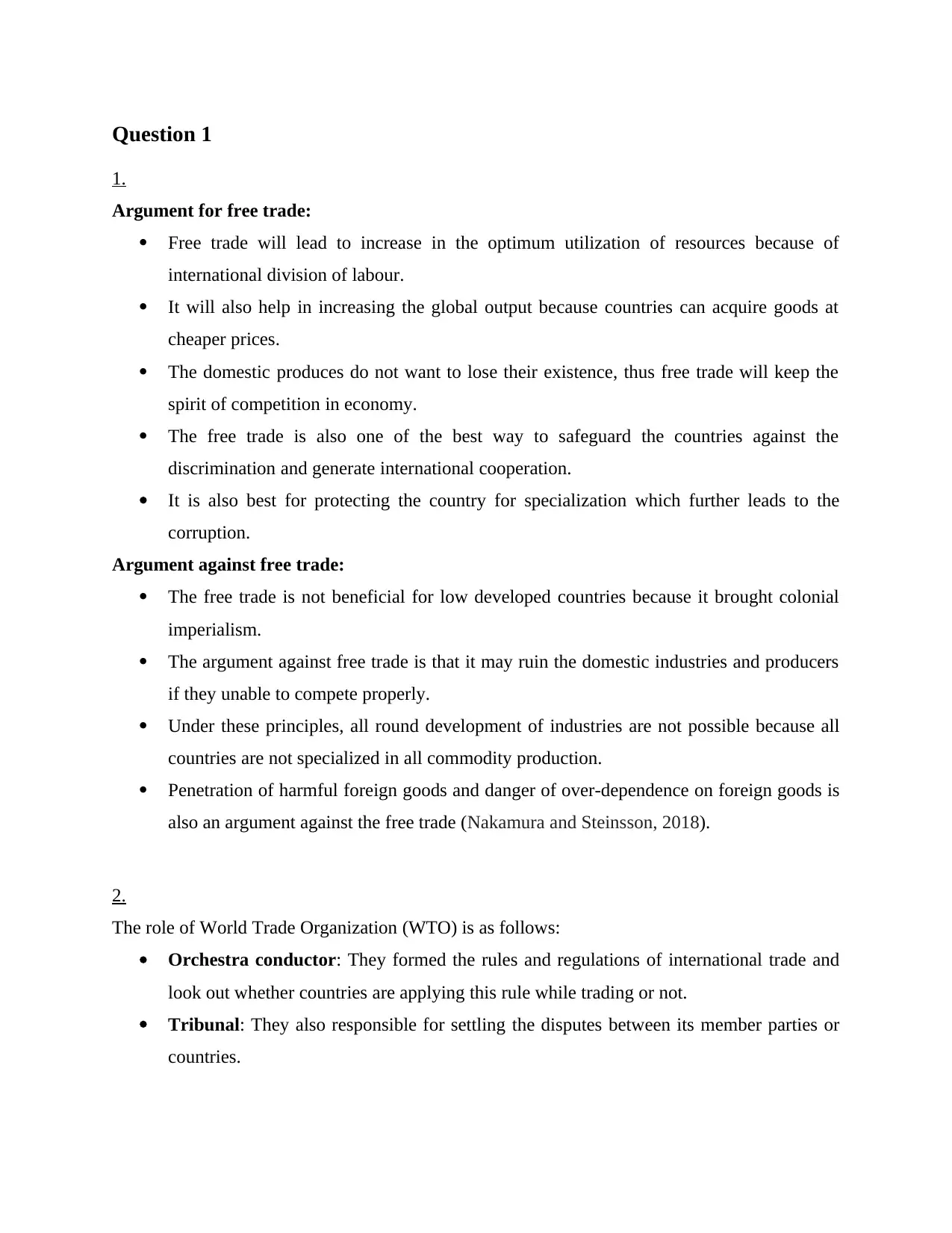
Question 1
1.
Argument for free trade:
Free trade will lead to increase in the optimum utilization of resources because of
international division of labour.
It will also help in increasing the global output because countries can acquire goods at
cheaper prices.
The domestic produces do not want to lose their existence, thus free trade will keep the
spirit of competition in economy.
The free trade is also one of the best way to safeguard the countries against the
discrimination and generate international cooperation.
It is also best for protecting the country for specialization which further leads to the
corruption.
Argument against free trade:
The free trade is not beneficial for low developed countries because it brought colonial
imperialism.
The argument against free trade is that it may ruin the domestic industries and producers
if they unable to compete properly.
Under these principles, all round development of industries are not possible because all
countries are not specialized in all commodity production.
Penetration of harmful foreign goods and danger of over-dependence on foreign goods is
also an argument against the free trade (Nakamura and Steinsson, 2018).
2.
The role of World Trade Organization (WTO) is as follows:
Orchestra conductor: They formed the rules and regulations of international trade and
look out whether countries are applying this rule while trading or not.
Tribunal: They also responsible for settling the disputes between its member parties or
countries.
1.
Argument for free trade:
Free trade will lead to increase in the optimum utilization of resources because of
international division of labour.
It will also help in increasing the global output because countries can acquire goods at
cheaper prices.
The domestic produces do not want to lose their existence, thus free trade will keep the
spirit of competition in economy.
The free trade is also one of the best way to safeguard the countries against the
discrimination and generate international cooperation.
It is also best for protecting the country for specialization which further leads to the
corruption.
Argument against free trade:
The free trade is not beneficial for low developed countries because it brought colonial
imperialism.
The argument against free trade is that it may ruin the domestic industries and producers
if they unable to compete properly.
Under these principles, all round development of industries are not possible because all
countries are not specialized in all commodity production.
Penetration of harmful foreign goods and danger of over-dependence on foreign goods is
also an argument against the free trade (Nakamura and Steinsson, 2018).
2.
The role of World Trade Organization (WTO) is as follows:
Orchestra conductor: They formed the rules and regulations of international trade and
look out whether countries are applying this rule while trading or not.
Tribunal: They also responsible for settling the disputes between its member parties or
countries.
⊘ This is a preview!⊘
Do you want full access?
Subscribe today to unlock all pages.

Trusted by 1+ million students worldwide
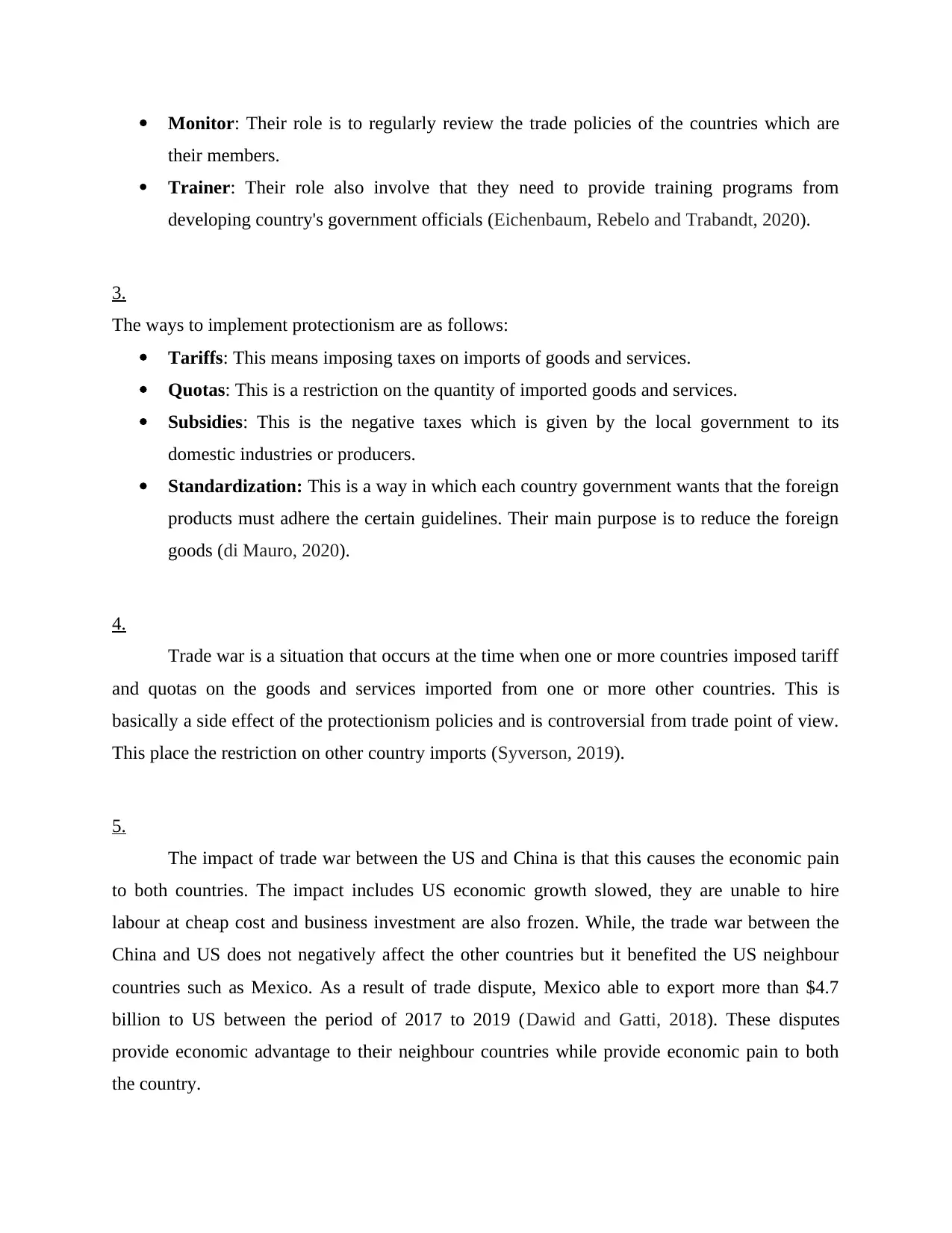
Monitor: Their role is to regularly review the trade policies of the countries which are
their members.
Trainer: Their role also involve that they need to provide training programs from
developing country's government officials (Eichenbaum, Rebelo and Trabandt, 2020).
3.
The ways to implement protectionism are as follows:
Tariffs: This means imposing taxes on imports of goods and services.
Quotas: This is a restriction on the quantity of imported goods and services.
Subsidies: This is the negative taxes which is given by the local government to its
domestic industries or producers.
Standardization: This is a way in which each country government wants that the foreign
products must adhere the certain guidelines. Their main purpose is to reduce the foreign
goods (di Mauro, 2020).
4.
Trade war is a situation that occurs at the time when one or more countries imposed tariff
and quotas on the goods and services imported from one or more other countries. This is
basically a side effect of the protectionism policies and is controversial from trade point of view.
This place the restriction on other country imports (Syverson, 2019).
5.
The impact of trade war between the US and China is that this causes the economic pain
to both countries. The impact includes US economic growth slowed, they are unable to hire
labour at cheap cost and business investment are also frozen. While, the trade war between the
China and US does not negatively affect the other countries but it benefited the US neighbour
countries such as Mexico. As a result of trade dispute, Mexico able to export more than $4.7
billion to US between the period of 2017 to 2019 (Dawid and Gatti, 2018). These disputes
provide economic advantage to their neighbour countries while provide economic pain to both
the country.
their members.
Trainer: Their role also involve that they need to provide training programs from
developing country's government officials (Eichenbaum, Rebelo and Trabandt, 2020).
3.
The ways to implement protectionism are as follows:
Tariffs: This means imposing taxes on imports of goods and services.
Quotas: This is a restriction on the quantity of imported goods and services.
Subsidies: This is the negative taxes which is given by the local government to its
domestic industries or producers.
Standardization: This is a way in which each country government wants that the foreign
products must adhere the certain guidelines. Their main purpose is to reduce the foreign
goods (di Mauro, 2020).
4.
Trade war is a situation that occurs at the time when one or more countries imposed tariff
and quotas on the goods and services imported from one or more other countries. This is
basically a side effect of the protectionism policies and is controversial from trade point of view.
This place the restriction on other country imports (Syverson, 2019).
5.
The impact of trade war between the US and China is that this causes the economic pain
to both countries. The impact includes US economic growth slowed, they are unable to hire
labour at cheap cost and business investment are also frozen. While, the trade war between the
China and US does not negatively affect the other countries but it benefited the US neighbour
countries such as Mexico. As a result of trade dispute, Mexico able to export more than $4.7
billion to US between the period of 2017 to 2019 (Dawid and Gatti, 2018). These disputes
provide economic advantage to their neighbour countries while provide economic pain to both
the country.
Paraphrase This Document
Need a fresh take? Get an instant paraphrase of this document with our AI Paraphraser
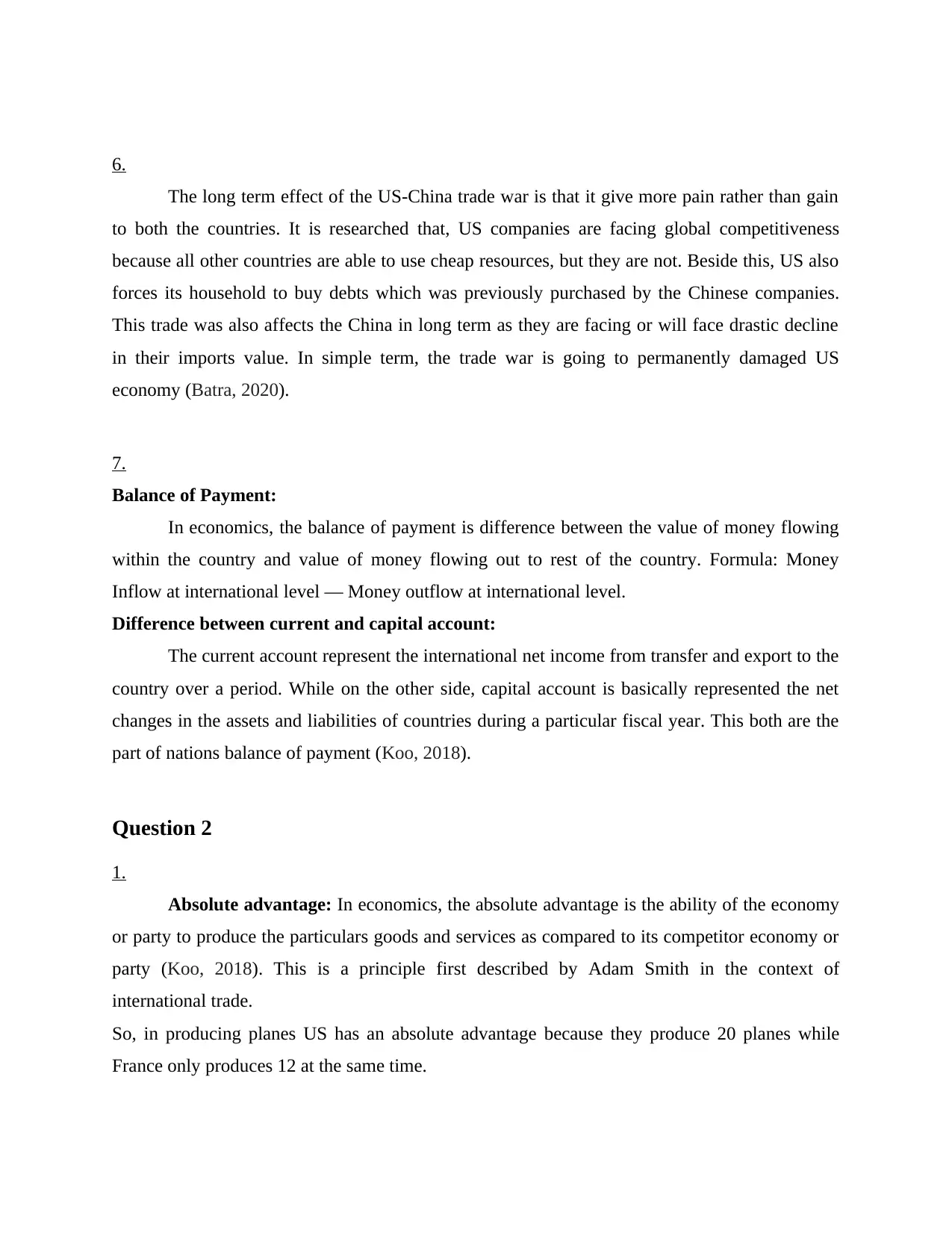
6.
The long term effect of the US-China trade war is that it give more pain rather than gain
to both the countries. It is researched that, US companies are facing global competitiveness
because all other countries are able to use cheap resources, but they are not. Beside this, US also
forces its household to buy debts which was previously purchased by the Chinese companies.
This trade was also affects the China in long term as they are facing or will face drastic decline
in their imports value. In simple term, the trade war is going to permanently damaged US
economy (Batra, 2020).
7.
Balance of Payment:
In economics, the balance of payment is difference between the value of money flowing
within the country and value of money flowing out to rest of the country. Formula: Money
Inflow at international level — Money outflow at international level.
Difference between current and capital account:
The current account represent the international net income from transfer and export to the
country over a period. While on the other side, capital account is basically represented the net
changes in the assets and liabilities of countries during a particular fiscal year. This both are the
part of nations balance of payment (Koo, 2018).
Question 2
1.
Absolute advantage: In economics, the absolute advantage is the ability of the economy
or party to produce the particulars goods and services as compared to its competitor economy or
party (Koo, 2018). This is a principle first described by Adam Smith in the context of
international trade.
So, in producing planes US has an absolute advantage because they produce 20 planes while
France only produces 12 at the same time.
The long term effect of the US-China trade war is that it give more pain rather than gain
to both the countries. It is researched that, US companies are facing global competitiveness
because all other countries are able to use cheap resources, but they are not. Beside this, US also
forces its household to buy debts which was previously purchased by the Chinese companies.
This trade was also affects the China in long term as they are facing or will face drastic decline
in their imports value. In simple term, the trade war is going to permanently damaged US
economy (Batra, 2020).
7.
Balance of Payment:
In economics, the balance of payment is difference between the value of money flowing
within the country and value of money flowing out to rest of the country. Formula: Money
Inflow at international level — Money outflow at international level.
Difference between current and capital account:
The current account represent the international net income from transfer and export to the
country over a period. While on the other side, capital account is basically represented the net
changes in the assets and liabilities of countries during a particular fiscal year. This both are the
part of nations balance of payment (Koo, 2018).
Question 2
1.
Absolute advantage: In economics, the absolute advantage is the ability of the economy
or party to produce the particulars goods and services as compared to its competitor economy or
party (Koo, 2018). This is a principle first described by Adam Smith in the context of
international trade.
So, in producing planes US has an absolute advantage because they produce 20 planes while
France only produces 12 at the same time.
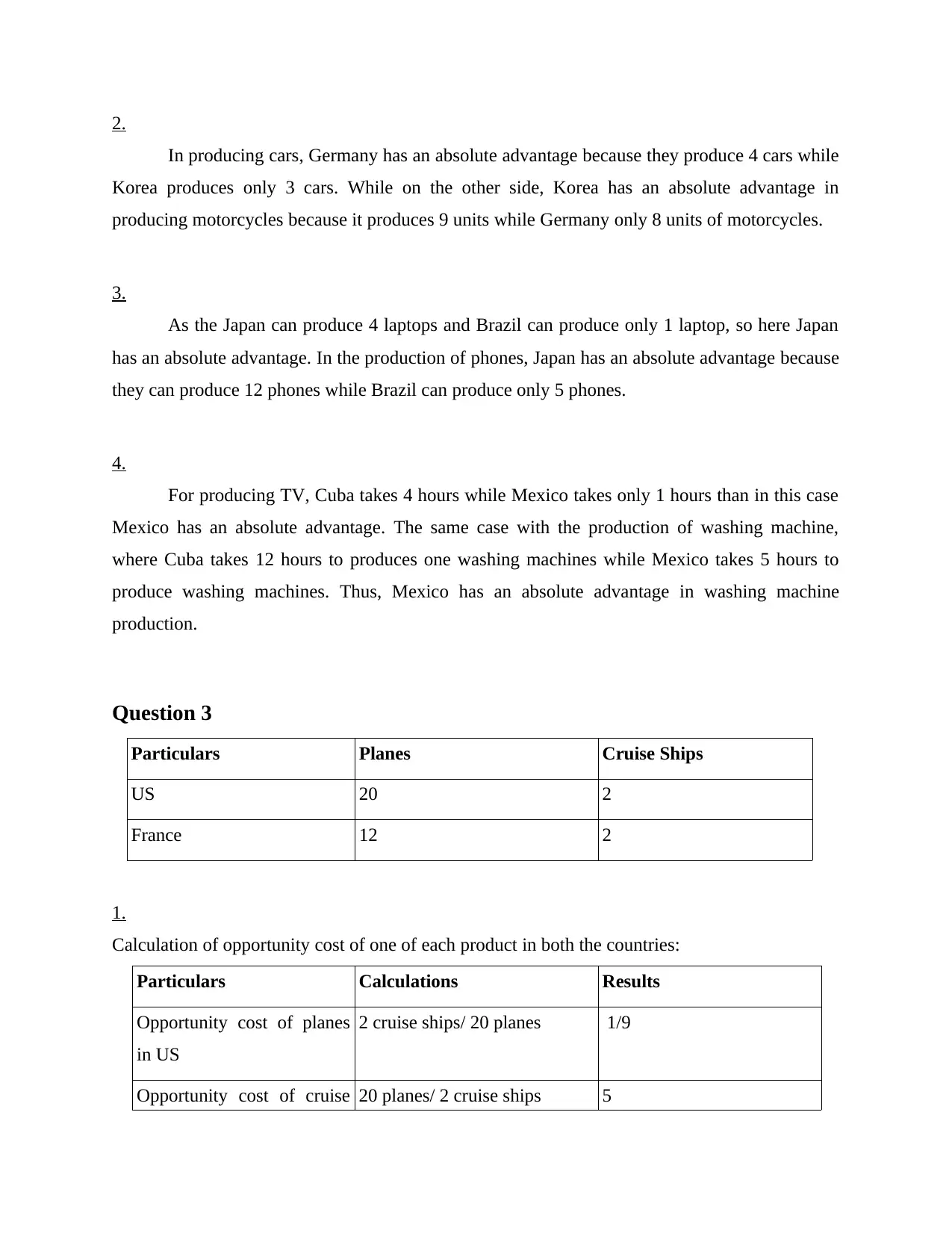
2.
In producing cars, Germany has an absolute advantage because they produce 4 cars while
Korea produces only 3 cars. While on the other side, Korea has an absolute advantage in
producing motorcycles because it produces 9 units while Germany only 8 units of motorcycles.
3.
As the Japan can produce 4 laptops and Brazil can produce only 1 laptop, so here Japan
has an absolute advantage. In the production of phones, Japan has an absolute advantage because
they can produce 12 phones while Brazil can produce only 5 phones.
4.
For producing TV, Cuba takes 4 hours while Mexico takes only 1 hours than in this case
Mexico has an absolute advantage. The same case with the production of washing machine,
where Cuba takes 12 hours to produces one washing machines while Mexico takes 5 hours to
produce washing machines. Thus, Mexico has an absolute advantage in washing machine
production.
Question 3
Particulars Planes Cruise Ships
US 20 2
France 12 2
1.
Calculation of opportunity cost of one of each product in both the countries:
Particulars Calculations Results
Opportunity cost of planes
in US
2 cruise ships/ 20 planes 1/9
Opportunity cost of cruise 20 planes/ 2 cruise ships 5
In producing cars, Germany has an absolute advantage because they produce 4 cars while
Korea produces only 3 cars. While on the other side, Korea has an absolute advantage in
producing motorcycles because it produces 9 units while Germany only 8 units of motorcycles.
3.
As the Japan can produce 4 laptops and Brazil can produce only 1 laptop, so here Japan
has an absolute advantage. In the production of phones, Japan has an absolute advantage because
they can produce 12 phones while Brazil can produce only 5 phones.
4.
For producing TV, Cuba takes 4 hours while Mexico takes only 1 hours than in this case
Mexico has an absolute advantage. The same case with the production of washing machine,
where Cuba takes 12 hours to produces one washing machines while Mexico takes 5 hours to
produce washing machines. Thus, Mexico has an absolute advantage in washing machine
production.
Question 3
Particulars Planes Cruise Ships
US 20 2
France 12 2
1.
Calculation of opportunity cost of one of each product in both the countries:
Particulars Calculations Results
Opportunity cost of planes
in US
2 cruise ships/ 20 planes 1/9
Opportunity cost of cruise 20 planes/ 2 cruise ships 5
⊘ This is a preview!⊘
Do you want full access?
Subscribe today to unlock all pages.

Trusted by 1+ million students worldwide
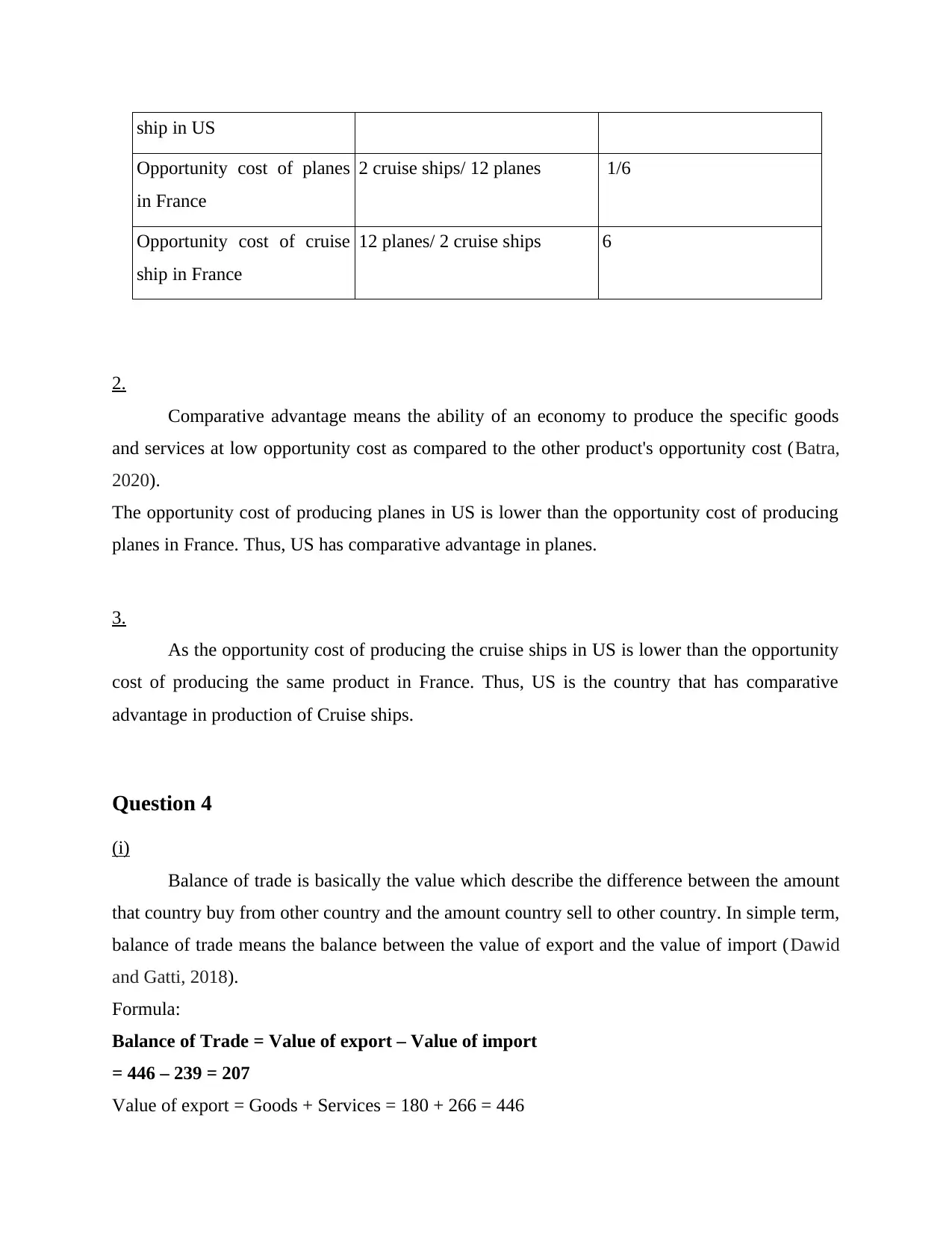
ship in US
Opportunity cost of planes
in France
2 cruise ships/ 12 planes 1/6
Opportunity cost of cruise
ship in France
12 planes/ 2 cruise ships 6
2.
Comparative advantage means the ability of an economy to produce the specific goods
and services at low opportunity cost as compared to the other product's opportunity cost (Batra,
2020).
The opportunity cost of producing planes in US is lower than the opportunity cost of producing
planes in France. Thus, US has comparative advantage in planes.
3.
As the opportunity cost of producing the cruise ships in US is lower than the opportunity
cost of producing the same product in France. Thus, US is the country that has comparative
advantage in production of Cruise ships.
Question 4
(i)
Balance of trade is basically the value which describe the difference between the amount
that country buy from other country and the amount country sell to other country. In simple term,
balance of trade means the balance between the value of export and the value of import (Dawid
and Gatti, 2018).
Formula:
Balance of Trade = Value of export – Value of import
= 446 – 239 = 207
Value of export = Goods + Services = 180 + 266 = 446
Opportunity cost of planes
in France
2 cruise ships/ 12 planes 1/6
Opportunity cost of cruise
ship in France
12 planes/ 2 cruise ships 6
2.
Comparative advantage means the ability of an economy to produce the specific goods
and services at low opportunity cost as compared to the other product's opportunity cost (Batra,
2020).
The opportunity cost of producing planes in US is lower than the opportunity cost of producing
planes in France. Thus, US has comparative advantage in planes.
3.
As the opportunity cost of producing the cruise ships in US is lower than the opportunity
cost of producing the same product in France. Thus, US is the country that has comparative
advantage in production of Cruise ships.
Question 4
(i)
Balance of trade is basically the value which describe the difference between the amount
that country buy from other country and the amount country sell to other country. In simple term,
balance of trade means the balance between the value of export and the value of import (Dawid
and Gatti, 2018).
Formula:
Balance of Trade = Value of export – Value of import
= 446 – 239 = 207
Value of export = Goods + Services = 180 + 266 = 446
Paraphrase This Document
Need a fresh take? Get an instant paraphrase of this document with our AI Paraphraser
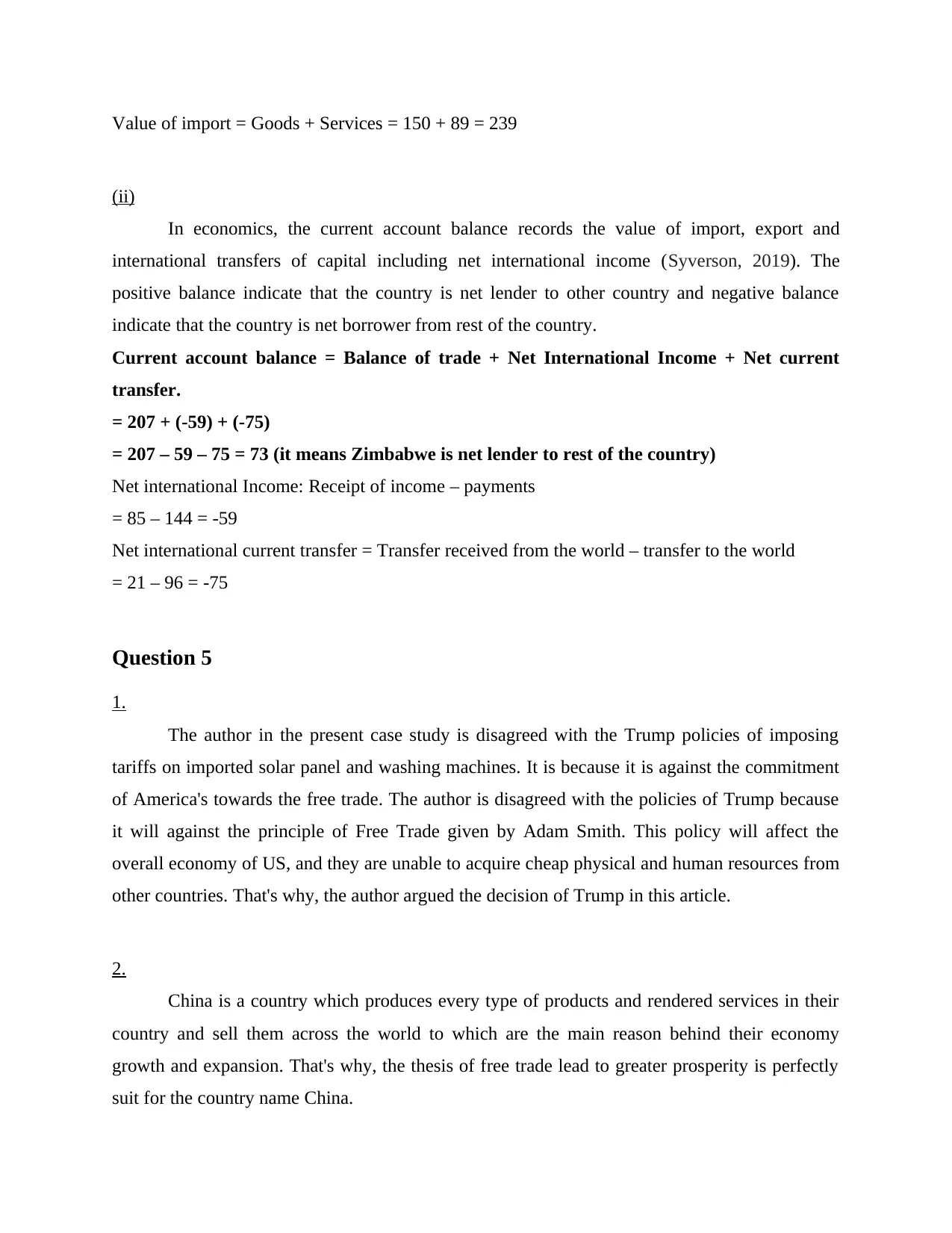
Value of import = Goods + Services = 150 + 89 = 239
(ii)
In economics, the current account balance records the value of import, export and
international transfers of capital including net international income (Syverson, 2019). The
positive balance indicate that the country is net lender to other country and negative balance
indicate that the country is net borrower from rest of the country.
Current account balance = Balance of trade + Net International Income + Net current
transfer.
= 207 + (-59) + (-75)
= 207 – 59 – 75 = 73 (it means Zimbabwe is net lender to rest of the country)
Net international Income: Receipt of income – payments
= 85 – 144 = -59
Net international current transfer = Transfer received from the world – transfer to the world
= 21 – 96 = -75
Question 5
1.
The author in the present case study is disagreed with the Trump policies of imposing
tariffs on imported solar panel and washing machines. It is because it is against the commitment
of America's towards the free trade. The author is disagreed with the policies of Trump because
it will against the principle of Free Trade given by Adam Smith. This policy will affect the
overall economy of US, and they are unable to acquire cheap physical and human resources from
other countries. That's why, the author argued the decision of Trump in this article.
2.
China is a country which produces every type of products and rendered services in their
country and sell them across the world to which are the main reason behind their economy
growth and expansion. That's why, the thesis of free trade lead to greater prosperity is perfectly
suit for the country name China.
(ii)
In economics, the current account balance records the value of import, export and
international transfers of capital including net international income (Syverson, 2019). The
positive balance indicate that the country is net lender to other country and negative balance
indicate that the country is net borrower from rest of the country.
Current account balance = Balance of trade + Net International Income + Net current
transfer.
= 207 + (-59) + (-75)
= 207 – 59 – 75 = 73 (it means Zimbabwe is net lender to rest of the country)
Net international Income: Receipt of income – payments
= 85 – 144 = -59
Net international current transfer = Transfer received from the world – transfer to the world
= 21 – 96 = -75
Question 5
1.
The author in the present case study is disagreed with the Trump policies of imposing
tariffs on imported solar panel and washing machines. It is because it is against the commitment
of America's towards the free trade. The author is disagreed with the policies of Trump because
it will against the principle of Free Trade given by Adam Smith. This policy will affect the
overall economy of US, and they are unable to acquire cheap physical and human resources from
other countries. That's why, the author argued the decision of Trump in this article.
2.
China is a country which produces every type of products and rendered services in their
country and sell them across the world to which are the main reason behind their economy
growth and expansion. That's why, the thesis of free trade lead to greater prosperity is perfectly
suit for the country name China.
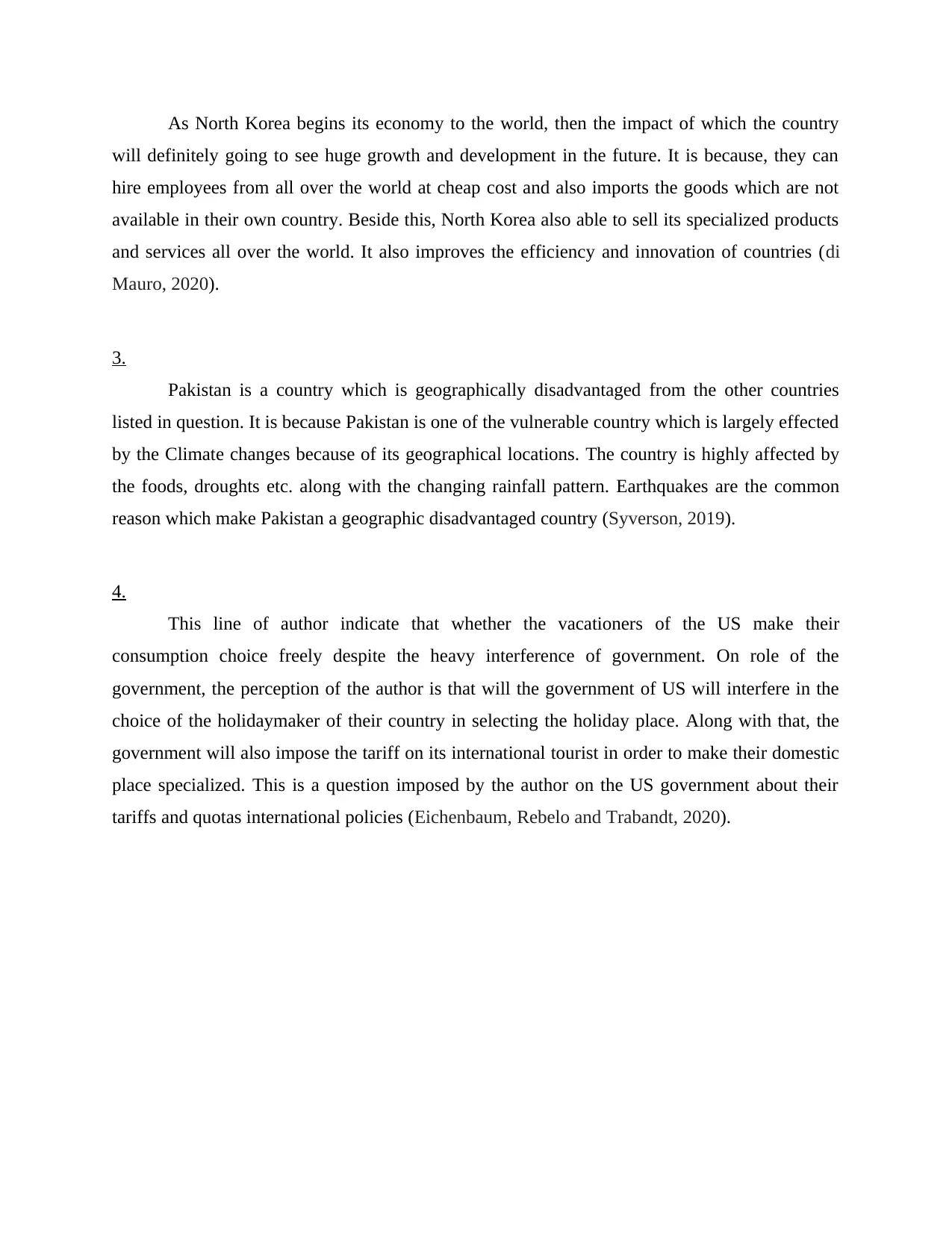
As North Korea begins its economy to the world, then the impact of which the country
will definitely going to see huge growth and development in the future. It is because, they can
hire employees from all over the world at cheap cost and also imports the goods which are not
available in their own country. Beside this, North Korea also able to sell its specialized products
and services all over the world. It also improves the efficiency and innovation of countries (di
Mauro, 2020).
3.
Pakistan is a country which is geographically disadvantaged from the other countries
listed in question. It is because Pakistan is one of the vulnerable country which is largely effected
by the Climate changes because of its geographical locations. The country is highly affected by
the foods, droughts etc. along with the changing rainfall pattern. Earthquakes are the common
reason which make Pakistan a geographic disadvantaged country (Syverson, 2019).
4.
This line of author indicate that whether the vacationers of the US make their
consumption choice freely despite the heavy interference of government. On role of the
government, the perception of the author is that will the government of US will interfere in the
choice of the holidaymaker of their country in selecting the holiday place. Along with that, the
government will also impose the tariff on its international tourist in order to make their domestic
place specialized. This is a question imposed by the author on the US government about their
tariffs and quotas international policies (Eichenbaum, Rebelo and Trabandt, 2020).
will definitely going to see huge growth and development in the future. It is because, they can
hire employees from all over the world at cheap cost and also imports the goods which are not
available in their own country. Beside this, North Korea also able to sell its specialized products
and services all over the world. It also improves the efficiency and innovation of countries (di
Mauro, 2020).
3.
Pakistan is a country which is geographically disadvantaged from the other countries
listed in question. It is because Pakistan is one of the vulnerable country which is largely effected
by the Climate changes because of its geographical locations. The country is highly affected by
the foods, droughts etc. along with the changing rainfall pattern. Earthquakes are the common
reason which make Pakistan a geographic disadvantaged country (Syverson, 2019).
4.
This line of author indicate that whether the vacationers of the US make their
consumption choice freely despite the heavy interference of government. On role of the
government, the perception of the author is that will the government of US will interfere in the
choice of the holidaymaker of their country in selecting the holiday place. Along with that, the
government will also impose the tariff on its international tourist in order to make their domestic
place specialized. This is a question imposed by the author on the US government about their
tariffs and quotas international policies (Eichenbaum, Rebelo and Trabandt, 2020).
⊘ This is a preview!⊘
Do you want full access?
Subscribe today to unlock all pages.

Trusted by 1+ million students worldwide
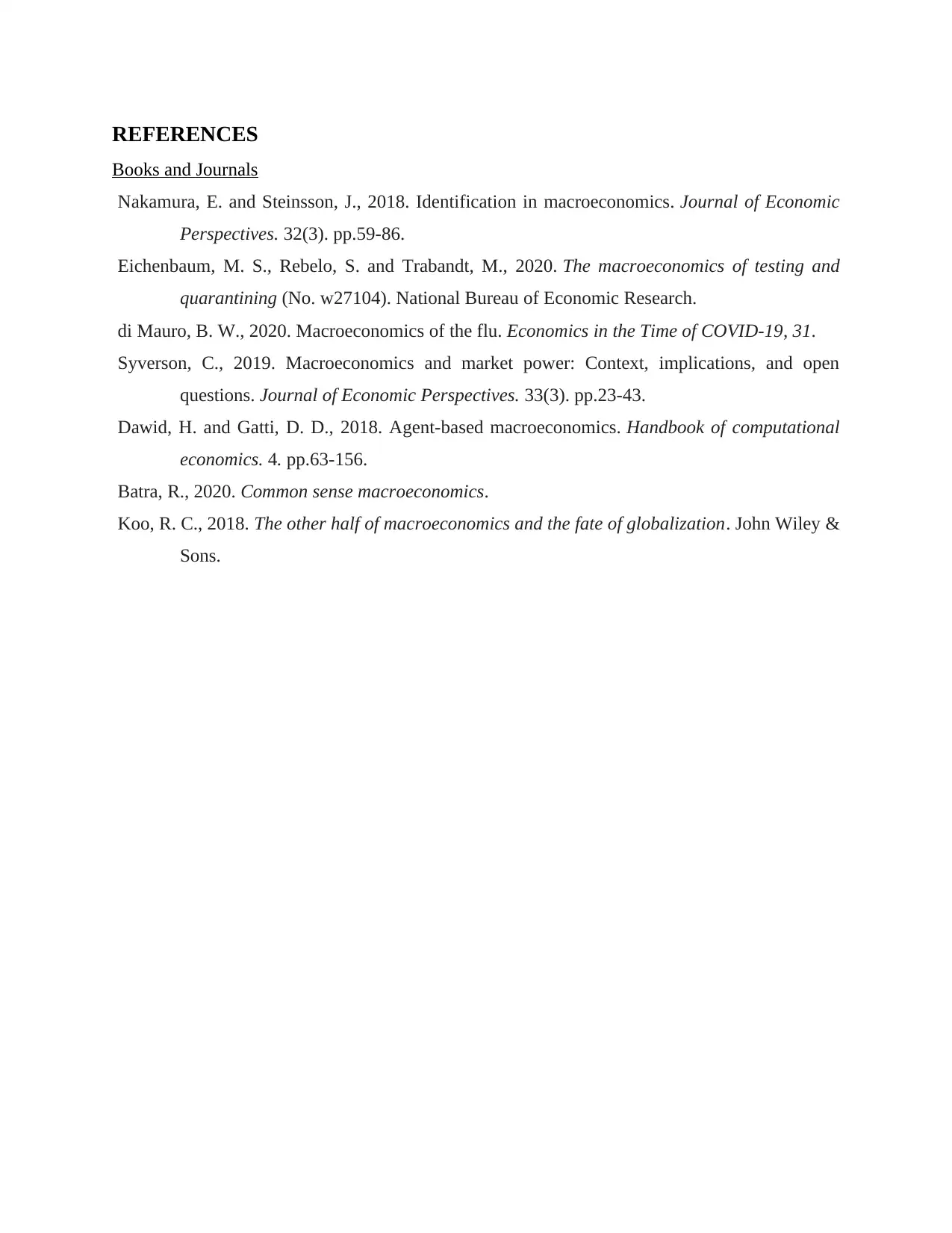
REFERENCES
Books and Journals
Nakamura, E. and Steinsson, J., 2018. Identification in macroeconomics. Journal of Economic
Perspectives. 32(3). pp.59-86.
Eichenbaum, M. S., Rebelo, S. and Trabandt, M., 2020. The macroeconomics of testing and
quarantining (No. w27104). National Bureau of Economic Research.
di Mauro, B. W., 2020. Macroeconomics of the flu. Economics in the Time of COVID-19, 31.
Syverson, C., 2019. Macroeconomics and market power: Context, implications, and open
questions. Journal of Economic Perspectives. 33(3). pp.23-43.
Dawid, H. and Gatti, D. D., 2018. Agent-based macroeconomics. Handbook of computational
economics. 4. pp.63-156.
Batra, R., 2020. Common sense macroeconomics.
Koo, R. C., 2018. The other half of macroeconomics and the fate of globalization. John Wiley &
Sons.
Books and Journals
Nakamura, E. and Steinsson, J., 2018. Identification in macroeconomics. Journal of Economic
Perspectives. 32(3). pp.59-86.
Eichenbaum, M. S., Rebelo, S. and Trabandt, M., 2020. The macroeconomics of testing and
quarantining (No. w27104). National Bureau of Economic Research.
di Mauro, B. W., 2020. Macroeconomics of the flu. Economics in the Time of COVID-19, 31.
Syverson, C., 2019. Macroeconomics and market power: Context, implications, and open
questions. Journal of Economic Perspectives. 33(3). pp.23-43.
Dawid, H. and Gatti, D. D., 2018. Agent-based macroeconomics. Handbook of computational
economics. 4. pp.63-156.
Batra, R., 2020. Common sense macroeconomics.
Koo, R. C., 2018. The other half of macroeconomics and the fate of globalization. John Wiley &
Sons.
1 out of 10
Related Documents
Your All-in-One AI-Powered Toolkit for Academic Success.
+13062052269
info@desklib.com
Available 24*7 on WhatsApp / Email
![[object Object]](/_next/static/media/star-bottom.7253800d.svg)
Unlock your academic potential
Copyright © 2020–2025 A2Z Services. All Rights Reserved. Developed and managed by ZUCOL.




